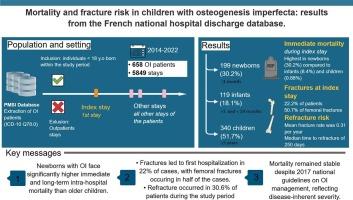成骨不全儿童的死亡率和骨折风险:来自法国全国医院出院数据库的结果
IF 3.6
2区 医学
Q2 ENDOCRINOLOGY & METABOLISM
引用次数: 0
摘要
成骨不全症(OI)是一种罕见的遗传性疾病,可导致骨脆性和复发性骨折。很少有研究利用健康声明数据评估其负担。本研究评估了成骨不全儿童的即时和长期死亡率及骨折风险。方法:该历史队列包括来自法国全国出院数据库(2014-2022)的首次住院记录为成骨不全症诊断的儿童。2014年之前出生的孩子被排除在外。根据患者在指数住院时的年龄,将患者分为新生儿(≤1个月)、婴儿(1 ~ 24个月)和儿童(≥2岁)。使用描述性统计、Kaplan-Meier估计和Cox模型分析即时死亡率(住院期间或当日转移后)和长期死亡率以及骨折风险。结果共纳入658例患者(5849次住院),平均年龄1.59岁,其中新生儿占30.2%,婴儿占18.1%,儿童占51.7%。79名儿童(12.0%)死亡,新生儿(30.2%)的立即死亡率高于婴儿(8.4%)和儿童(0.9%)(p <;0.001)。死产占死亡人数的69.9%。新生儿6个月生存率为68.3% (95% CI[62.2-75.1])。在指数住院时,146例(22.2%)患者发生骨折,主要是股骨骨折(50.7%)。随访期间,17.9%的患者出现高骨折率(>;0.5/年)。46.9%的患者是高护理使用者(≥1次住院/年)。结论成骨不全新生儿的即时和长期住院死亡率明显高于婴儿和儿童,是普通人群的126倍。尽管有国家指导方针,但2017年后死亡率保持稳定。四分之一的患者在住院期间发生骨折,其中一半涉及股骨。本文章由计算机程序翻译,如有差异,请以英文原文为准。

Mortality and fracture risk in children with osteogenesis imperfecta: Results from the French nationwide hospital discharge database
Introduction
Osteogenesis imperfecta (OI) is a rare genetic disorder causing bone fragility and recurrent fractures. Few studies have assessed its burden using health claims data. This study evaluated immediate and long-term mortality and fracture risk in children with OI.
Methods
This historical cohort included children with a first inpatient stay recording an OI diagnosis, from the French nationwide hospital discharge database (2014–2022). Children born before 2014 were excluded. Based on age at index stay, patients were classified as newborns (≤1 month), infants (>1–<24 months), or children (≥2 years). Immediate mortality (during the index stay or after same-day transfer) and long-term mortality were analyzed along with fracture risk using descriptive statistics, Kaplan-Meier estimates, and Cox models.
Results
A total of 658 patients (5849 stays) were included (mean age 1.59 years): 30.2 % were newborns, 18.1 % infants, and 51.7 % children. Seventy-nine children (12.0 %) died, with immediate mortality higher in newborns (30.2 %) than infants (8.4 %) and children (0.9 %) (p < 0.001). Stillbirth accounted for 69.9 % of deaths. Six-month survival for newborns was 68.3 % (95 % CI [62.2–75.1]). At index stay, 146 patients (22.2 %) had fractures, mainly femoral (50.7 %). During follow-up, 17.9 % presented a high fracture rate (>0.5/year). 46.9 % of patients were high care users (≥1 stay/year).
Conclusion
Newborns with OI face significantly higher immediate and long-term in-hospital mortality than infants and children, and 126 times higher than that of the general population. Mortality remained stable post-2017 despite national guidelines. A quarter of patients had fractures at index stay, half of which involved the femur.
求助全文
通过发布文献求助,成功后即可免费获取论文全文。
去求助
来源期刊

Bone
医学-内分泌学与代谢
CiteScore
8.90
自引率
4.90%
发文量
264
审稿时长
30 days
期刊介绍:
BONE is an interdisciplinary forum for the rapid publication of original articles and reviews on basic, translational, and clinical aspects of bone and mineral metabolism. The Journal also encourages submissions related to interactions of bone with other organ systems, including cartilage, endocrine, muscle, fat, neural, vascular, gastrointestinal, hematopoietic, and immune systems. Particular attention is placed on the application of experimental studies to clinical practice.
 求助内容:
求助内容: 应助结果提醒方式:
应助结果提醒方式:


